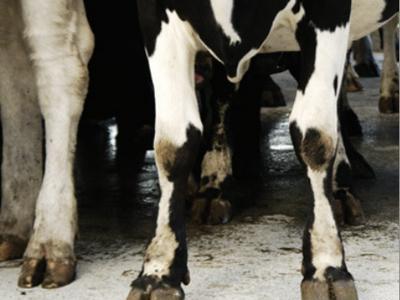Cow Health: Cow Lameness

Lameness is caused by many factors which differ between individual cows and farms. Reducing the number of lame cows on your farm therefore requires a long-term, planned approach that is supported by the whole farm team.
Why worry about lame cows?
- Lame cows cost you time and money
- Are a serious welfare problem
- Affect staff morale.
Poor cow management
Poor cow management is responsible for many of the lame cows in New Zealand dairy herds.
How good is the stockmanship on your farm?
- Have you ever taken the time to observe cows as they move on races and in the yards during milking?
- Is everybody on your farm aware that if cows' heads are up they are under too much pressure?
- Do you detect lame cows before they are at the back of the herd and can't bear weight on their hoof?
- Does everybody on your farm understand how to use the backing gate to maximise cow flow and minimise hoof damage in the yards?
- Does everybody on your farm use the backing gate in the same way?
- Does everybody that treats lame cows equipped with the appropriate skills for the job?
- Do you have enough experienced staff treating lame cows to ensure that all lame cows are treated as early as possible?
If you did not answer yes to all these questions, the Healthy Hoof Programme will improve lame cow management on your farm.
Digital Dermatitis
Digital dermatitis is a highly infectious bacterial skin disease of the feet which is a significant cause of lameness in cattle overseas. It thrives on dirty feet and spreads in dirty conditions.
The disease was discovered in Italy in 1974 and was first identified in five New Zealand herds in 2011. Two years later a further 40 infected herds were discovered. A 2014-15 pilot study conducted in Taranaki found more than 50% of dairy herds tested had some infected animals.
To find out what Digital Dermatitis looks like, how to treat it and how to prevent it, download the Factsheet here.
Related information
Healthy Hoof programme
Lameness scoring
Lameness cost calculator
Có thể bạn quan tâm
 Cow Health: Copper deficiency
Cow Health: Copper deficiency Copper (Cu) deficiency in cattle is a common and complex problem. Dairy cows are most likely to be deficient in winter/early spring, coinciding with higher
 Cow Health: Sodium deficiency
Cow Health: Sodium deficiency Sodium is an essential element for animals. Dairy cows routinely expel Na from the body in urine, faeces, saliva and milk which has to be replaced.
 Cow Health: Ketosis in the cow
Cow Health: Ketosis in the cow Ketosis is a metabolic disease that occurs when the cow is in severe state of negative energy balance.